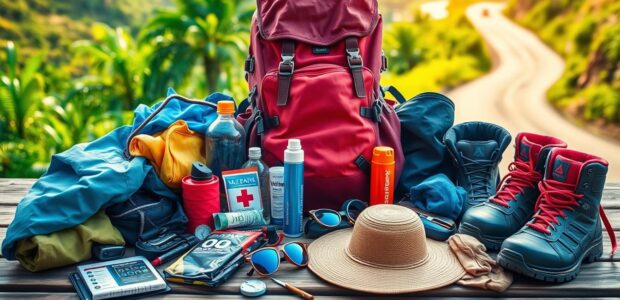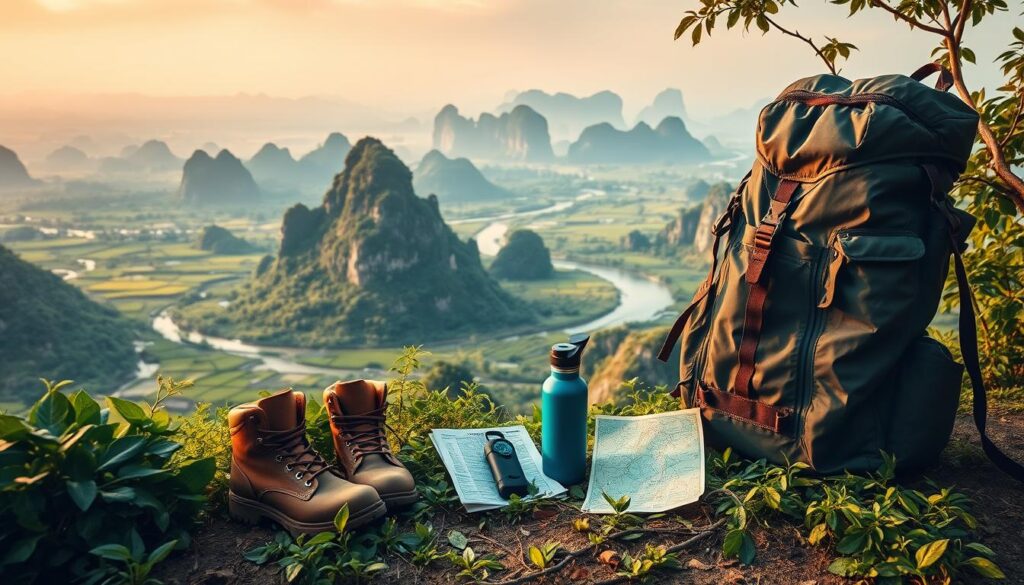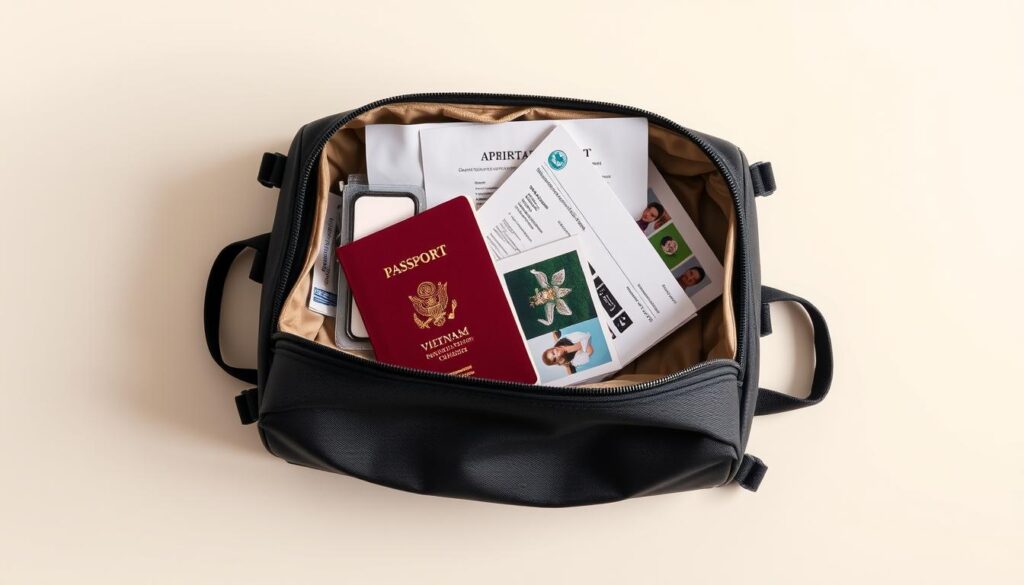
What to Pack for Vietnam: A Month-by-Month Guide
Are you planning a trip to Vietnam? Your packing list changes with the season and region. This guide helps you know what to bring each month. You’ll learn how to pack for Vietnam’s weather, from tropical rains in the south to cool winters in the north.
Whether you’re hiking in Sapa or exploring Ho Chi Minh City, you’ll stay comfortable. Discover how to match your luggage to Vietnam’s weather.
Key Takeaways
- Regional climates vary: pack light layers for southern humidity and warm layers for northern winters.
- Use month-by-month tips to avoid overpacking—perfect for the best time to travel to Vietnam.
- Follow expert advice from Tortuga’s packing guides for space-saving strategies.
- Hygiene and health items are vital for year-round travel comfort.
- Secure documents and visas to simplify border crossings and city tours.
Introduction to Vietnam’s Climate and Packing Essentials
When planning a vietnam travel itinerary, knowing the climate zones is key. The weather changes a lot from the cool mountains in the north to the warm south. Packing right means choosing clothes that fit the weather of each place you visit.
“A well-planned itinerary adapts to Vietnam’s regional climates, making packing a science, not a guess.”
Understanding Regional Weather Patterns
| Region | Climate Highlights |
|---|---|
| Northern Vietnam | Cold winters (Nov–Feb), hot summers |
| Central Vietnam | Distinct wet/dry seasons; typhoon risks |
| Southern Vietnam | Year-round warmth with monsoon rains |
Why Seasonal Packing Matters
- Mountain regions: Pack thermal layers and waterproof jackets
- Coastal areas: Include quick-dry clothing and sand-resistant footwear
- Tropical south: Prioritize lightweight fabrics and UV-protective gear
Your vietnam travel itinerary should match your destinations with the weather. Look up Tortuga’s packing lists or online guides for what you need for each area. The wrong clothes can ruin your trip. By packing right for Vietnam’s weather, your travels will be smooth.
Monthly Packing Essentials for a Seamless Journey
Before you travel, make sure your luggage fits Vietnam’s changing weather. Get your vietnam travel visa ready. Choose clothes that match the weather in each region.
| Month | North | Central | South |
|---|---|---|---|
| January | 14–20°C: Layers, jacket, raincoat. | 20–25°C: Lightweight, sun gear. | 25–30°C: Sun protection, swimwear. |
| February | 18–22°C: Warm jacket, hat. | 22–28°C: Breathable fabrics, sandals. | 28–30°C: Insect repellent, UV hat. |
| March | 20–24°C: Light layers, umbrella. | 24–30°C: Quick-dry clothing. | 29–31°C: Rain-ready gear. |
| April | 24–28°C: Breathable fabrics, sunscreen. | 27–32°C: Waterproof shoes. | 30–32°C: Foldable umbrella. |
| May | 28–32°C: Lightweight clothing, insect repellent. | 29–34°C: UV-protective gear. | 29–32°C: Quick-dry towels. |
| June | 30–34°C: Cooling accessories. | 30–35°C: Moisture-wicking fabrics. | 29–32°C: Rain jacket. |
Key Items to Pack Throughout the Year
- Lightweight fabrics for humidity
- Quick-dry swimwear for beach days
- Compact rain gear for sudden showers
- Insect repellent in all regions
- Comfortable shoes for trekking or city walks
- Carry a copy of your vietnam travel visa with essentials
Layer your clothes for changing temperatures. Always check your vietnam travel visa before you leave.
Discover the Best Time to Travel to Vietnam
When planning your best time to travel to Vietnam, think about the weather, crowds, and different regions. The north and south have very different climates. So, your trip plan should match what you want to do.
The dry season is from December to February, with mild temperatures everywhere. In the north, it’s cool, around 60–70°F (15–21°C), great for Hanoi’s Old Quarter or Sapa’s fields. The south is warm and dry, perfect for Mekong Delta tours.
- North: Opt for cooler months to hike Fansipan Mountain or enjoy quieter sightseeing.
- South: December–February is less crowded but avoids the rainy season’s humidity.
Monsoon seasons require flexibility. The south is wettest from May to October, with lush landscapes but lots of rain. The north’s monsoon hits in August to October, making mountain trips tough. But, traveling off-peak can save money and avoid crowds.
“Rainy seasons offer quieter beaches and lower costs—just pack waterproof gear.”
For cultural events, Lunar New Year (Tet) in late January/February is a good time, but book hotels early. If you’re into adventure, trek in the north during dry months. The best time to travel to Vietnam is when you balance your interests with the weather.
Essential Clothing and Gear for All Climates
Mastering your wardrobe and gear ensures comfort no matter Vietnam’s weather shifts. A well-planned vietnam travel itinerary starts with versatile clothing that adapts to every climate. Whether hiking mountain trails or exploring coastal towns, the right items simplify every step of your journey.

Tips for Layering and Rain Protection
Layering is key to staying comfortable in Vietnam’s changing weather. Start with breathable base layers like cotton or merino wool. Pair these with a waterproof jacket that fits into a small pack—sudden rain showers are common. Don’t forget a compact umbrella. Here’s how to layer effectively:
- Moisture-wicking tops for humidity
- Light fleece or fleece-lined jackets for cooler evenings
- Quick-dry pants that convert to shorts for flexibility
Selecting Footwear for Varied Terrains
Footwear choices depend on your itinerary’s highlights. Trekking boots are a must for Sapa’s trails, while sandals work for beach days. Prioritize comfort and durability:
- Waterproof hiking shoes for mountain hikes
- Comfortable walking shoes for city exploration
- Flip-flops for temple visits or beach time
Pair these picks with a waterproof backpack and portable travel towels. Every piece should support your vietnam travel itinerary’s demands, whether you’re cycling through Hoi An or navigating Hanoi’s markets.
Packing Smart for Vietnam’s Diverse Regions
Are you planning your vietnam travel visa and packing list? Northern and southern Vietnam have different needs. In the cool highlands near Sapa, wear thermal tops and waterproof jackets. For Ho Chi Minh City’s humid south, choose breathable linen shirts and quick-dry pants.
- Northern Essentials: fleece, hiking boots, waterproof backpack covers
- Southern Essentials: UV-protective hats, collapsible umbrella, lightweight sandals
“Pack like you’re splitting your suitcase between winter and summer,” says travel blogger Linh Nguyen. “One side for mountain mist, the other for beach breezes.”
Mountain treks need sturdy trekking poles, while coastal trips require reef-safe sunscreen. Always check your vietnam travel visa before moving between regions. Keep copies in both your luggage and daypacks for easy access.
Roll your clothes to save space and pack quick-dry towels for sudden rain. Use waterproof pouches for passports and electronics. This is key whether you’re in Hanoi’s markets or on Mekong Delta boat rides. A small first-aid kit is essential for any adventure.
How to Prepare Your Vietnam Travel Itinerary
Planning your Vietnam trip? The best time to travel to Vietnam changes by region. Match your trip with the local weather to enjoy more. Begin by picking key spots like Halong Bay or Sapa and plan them for their best seasons.
Integrate Regional Highlights into Your Plan
- Halong Bay: Visit April–June or September–November for sunny days perfect for cruises and kayaking. Avoid summer storms (June–August).
- Sapa: Time your trek to terraced rice fields for late April’s blossoms or October’s golden harvest. Winter visits (Dec–Feb) offer cooler air but require warm layers.
- Central Coast: Pair Hoi An’s lantern-lit streets with the dry season (February–April) for optimal sightseeing.
Optimize Your Schedule for Weather
Check local forecasts weeks before you go. For example, if visiting best time to travel to Vietnam’s rainy season (July–October), plan indoor activities on rainy days. Be flexible—monsoons can change quickly in mountains or by the sea.
Layer clothing for Sapa’s chilly mornings, even in summer. Pack lightweight rain gear if traveling during shoulder seasons. By combining weather data with must-see spots, your trip will be both smart and exciting.
Visa and Documentation Tips for Stress-Free Travel
Planning your vietnam travel itinerary begins with visa rules. Vietnam has updated its visa policies in August 2023. This makes it easier for most travelers to enter. Follow these steps for a smooth entry and to avoid delays.
Understanding Vietnam Travel Visa Requirements
Citizens from 13 countries, like Germany, France, and Japan, can enter visa-free for up to 45 days. Others need to apply for an e-visa online. You’ll need:
- A passport valid for 6+ months after your trip
- 4cm x 6cm passport photos (white background, neutral expression)
- Completed visa form and payment
| Country | Exemption Details |
|---|---|
| Germany | 45-day visa-free stay |
| Japan | 45-day visa-free stay |
| South Korea | 45-day visa-free stay |
Note: Full list includes 13 countries. Check official sources for full eligibility.
Keeping Your Important Documents Secure
Secure storage is key to avoid emergencies. Here’s how:
- Carry passport/visa copies in a money belt and leave originals in a hotel safe.
- Upload digital copies to encrypted cloud storage.
- Register with your embassy via Smart Traveler Enrollment.
Make sure your visa is valid for your vietnam travel itinerary dates. E-visas take 3–5 days to process. Stay organized and enjoy your trip without worries.
Traveling Light: Clever Packing Hacks and Tips
Learn to pack light with smart tips that save space and cut down on weight. Before you get your vietnam travel visa, try these easy packing methods.

- Use packing cubes to compress outfits and keep items wrinkle-free. Brands like Eagle Creek’s Stack‘d cubes save space and streamline organization.
- Pair toiletries with travel-sized containers. Opt for multi-use products, like a shampoo-conditioner hybrid, to cut down on bulk.
- Secure electronics in a padded pouch. Roll clothes around fragile items to prevent damage and save space.
“Packing cubes aren’t just for organization—they’re survival tools for the organized traveler.” — Adventure Packing Blog
Streamline electronics by carrying only essential chargers and adapters. A universal adapter like Anker’s PowerPort fits all voltage needs. Keep cables in a clear bag for easy access through security checks.
Store your vietnam travel visa in a waterproof pouch with copies of your passport and itinerary. Digital copies stored in encrypted cloud storage add an extra layer of security.
Layer clothing strategically: pack quick-dry fabrics and a waterproof jacket for sudden downpours. Fold items using the “roll, don’t fold” method to maximize suitcase space.
Remember, less is more. Every item you pack should serve multiple purposes. With these hacks, you’ll travel lighter, stay organized, and enjoy stress-free adventures across Vietnam’s diverse landscapes.
Adapting to Vietnam’s Seasonal Weather Changes
The weather in Vietnam can change quickly. A sunny morning can turn into rain by afternoon. To keep your trip smooth, learn how to adjust your packing and plans for any season.
Weather-Specific Packing Strategies
Layering is essential. For hot months, pack light fabrics for comfort. Carry a compact umbrella and waterproof shoe covers for sudden rains.
In the northern highlands, bring a fleece for cooler evenings, even in summer.
- Carry quick-dry towels and a portable fan for humid days.
- Use breathable materials to fight tropical heat in coastal areas.
How to Avoid Common Seasonal Pitfalls
Avoid overpacking by choosing versatile gear. Check local forecasts daily to adjust your plans. For example, in Dalat, temperatures drop sharply at night, so always keep a scarf handy.
Rainy seasons in central Vietnam peak from September to November—store electronics in ziplock bags. When visiting Ha Giang in winter, protect yourself from frosty mornings with thermal layers.
“Flexibility is your best tool here. The weather never stays the same for long.”
Stay prepared with these tips, and your best time to travel to vietnam adventure will stay on track no matter the forecast.
Maximizing Comfort: Health and Safety on the Road
Planning your vietnam travel itinerary is more than just picking places to go. It’s about keeping yourself healthy. Start by packing a first-aid kit with bandages, pain relievers, and motion sickness tablets. Don’t forget to bring a reusable water bottle to stay hydrated in the hot tropical weather.
Electrolyte tablets are also a must to replace salts lost through sweating. They help keep your body balanced.
- Hydrate before and after hikes in mountainous regions like Sapa.
- Carry sunscreen and a wide-brimmed hat to avoid sunburn.
- Include anti-diarrheal meds and anti-malarial pills if visiting rural areas.
“Carry a printed list of local emergency numbers and your itinerary’s daily locations.”
Look up hospitals near your vietnam travel itinerary stops. The French Hospital in Hanoi and Ho Chi Minh City have English-speaking staff. Also, find local clinics in smaller towns like Hoi An or Da Nang.
Keep copies of prescriptions and insurance cards in your daypack. Be careful with street food by asking locals for restaurant tips. Always check the weather forecast to adjust your plans if storms hit the central coast during rainy seasons.
Stay energized with light meals like bananas and energy bars. Bring a portable charger for your GPS apps. By focusing on health, every day of your vietnam travel itinerary will be safe and fun.
Conclusion
Planning your Vietnam trip means understanding its climate zones. Hanoi has cool winters, while the Mekong Delta is hot. Packing smart is key to comfort.
Check the weather for each place. Northern areas like Sapa need layers. Coastal spots like Da Nang require quick-dry clothes during the rainy season.
Get your Vietnam travel visa early and keep copies safe. Wear layers for temperature changes. Choose sturdy shoes for hikes or temple visits.
Review your packing list and itinerary. Match activities with the season. For example, Ha Long Bay in spring is less crowded but can be chilly.
Local festivals and monsoon schedules affect the best travel times. Whether exploring Hoi An or trekking in the Central Highlands, adapt your gear. Confirm visa needs and weather forecasts before you go.
A well-prepared traveler can enjoy Vietnam’s culture, landscapes, and seasonal beauty. Double-check your list, stay flexible, and let the journey begin!
FAQ
What is the best time to travel to Vietnam?
The best time to visit Vietnam is from November to April. This is when the weather is cooler and drier. But, the best time can change depending on where you plan to go.
Do I need a visa to travel to Vietnam?
Yes, most people need a Vietnam travel visa. Make sure to check the rules for your country. An e-visa is a good choice for an easy process.
How should I pack for Vietnam’s varying climates?
Pack clothes that can be layered for the warm south and cooler north. Remember to bring rain gear, as storms can happen, mainly during the monsoon.
What essential items should I bring year-round?
Always pack lightweight clothes, comfy shoes, a waterproof jacket, and a first aid kit. This way, you’re ready for anything.
How can I adapt my packing list based on the month I visit?
Think about the weather for your visit. For rainy months, bring waterproof stuff. In summer, pack light clothes.
What tips can help me reduce travel stress regarding documentation?
Keep your visa, passport, and insurance safe in a pouch. It’s smart to have both paper and digital copies.
How can I stay healthy while traveling in Vietnam?
Drink plenty of water and eat snacks. Know where to find healthcare and keep emergency numbers handy. A first aid kit is also useful.
What packing hacks can help me travel light?
Use packing cubes and roll clothes to save space. Choose items that can do more than one thing, like a scarf.
How do weather conditions affect my daily activities in Vietnam?
Weather can change your plans. If it’s going to rain, plan indoor activities. Staying updated on the weather helps you enjoy Vietnam more.
